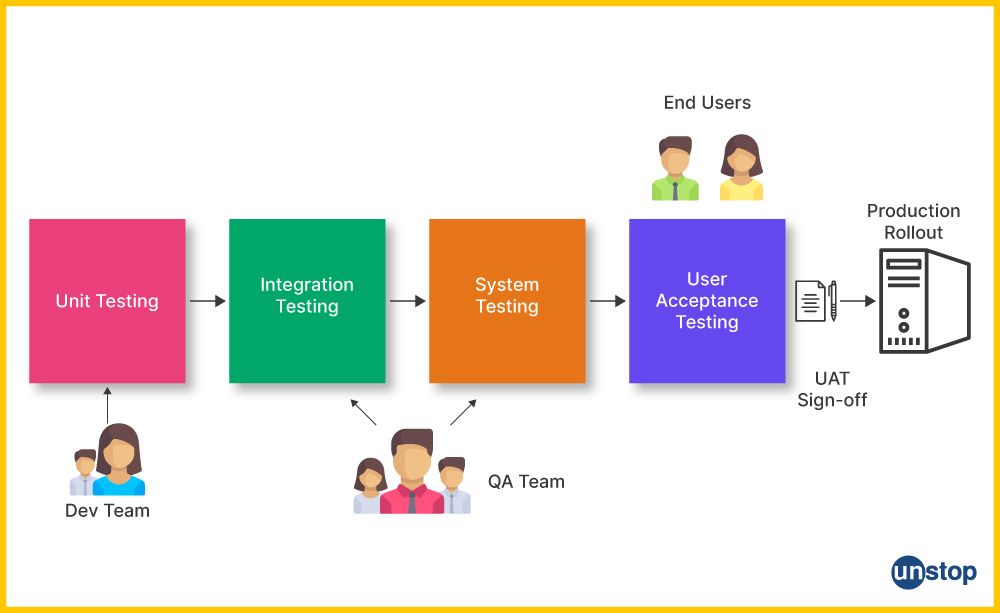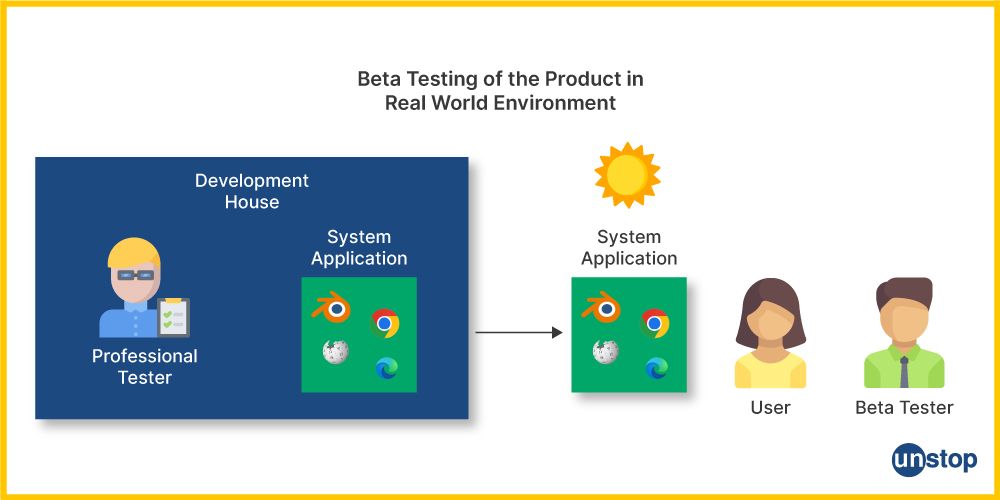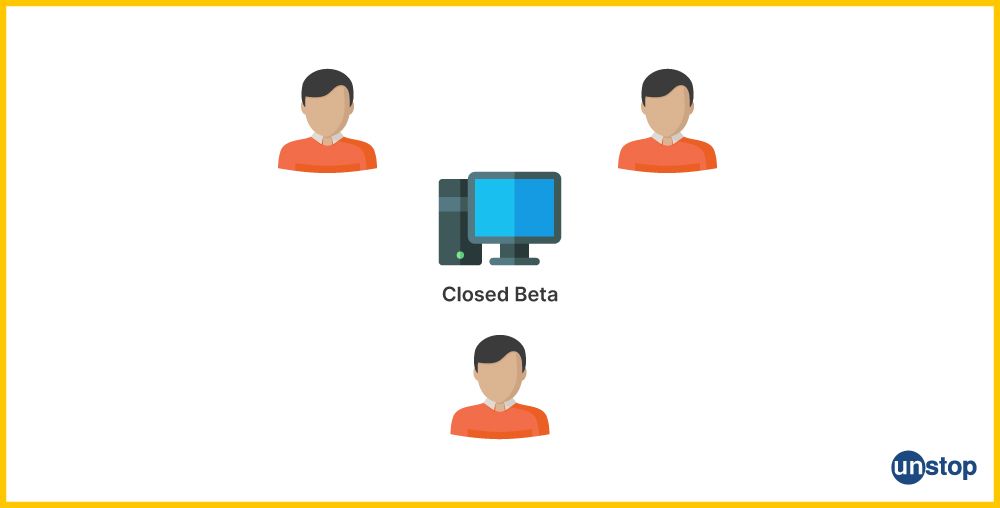- What is Beta Testing?
- Beta testing versus other types of testing
- Advantages of Beta Testing Phase
- Beta Testing Examples
- Beta testing challenges
- Summing Up
What Is Beta Testing? Understanding The Last Software Testing Stage

Software Testing involves assessing a product or service to discover any defects or problems for rectification before its launch in the market. These may include techniques like manual testing by individuals or automated testing using specialized software tools and user responses. Mostly, the phases differ from organization to organization but the general procedure is as follows:
- Pre-alpha testing: This is the testing done by an internal team during initial development when the product has limited features.
- Alpha testing: This is also done by an internal team in a controlled environment, but the product is at a more developed stage (Alpha version).
- Beta testing: This is the last testing before the software is released in the market.
This article will help to develop a deeper understanding of Beta testing. We will also see how this phase differs from the rest of the phases in software testing.
Also Read: Difference between Alpha Testing and Beta Testing
What is Beta Testing?
Beta testing (denoted by Greek alphabet β) is the last crucial phase in development and involves an elite group of people using an unreleased version of the product in development. This way, software developers get detailed user feedback that can be incorporated into the final product before it is launched into the market, thus mitigating product failure risk.
Beta testing comes in the User Acceptance Testing(UAT) and occurs after the software’s testing lifecycle. It can also work in external user acceptance testing since no users from the development team will be involved with it.

Beta testers comprise a mix of people, could be company's clients and potential users who fulfill predetermined selection standards defined by this company. Typically, these consumers are picked based on specific characteristics such as age, gender, education level, and proficiency in other related services. They are volunteers who share the truth about their experience with the product.
Beta testing process is carried out in an uncontrolled or actual testing environment where users are exposed to various equipment and networks. It simulates cases that might not be tested in the Alpha phase.

Organizations can also use the Beta testing technique in six ways with varying focus on different elements in the software.
- Open Beta Testing - Inviting scores of ordinary people to test and appraise a product before releasing it officially on the market for sale. It will also enable participants who have used the product to shed light on their experiences, such as issues they encountered and ways of improving it.

Is Beta testing the same as Black-Box testing? Black-box testing is a type of software testing that focuses on the external behavior of a program without knowledge of its internal code, while Beta testing is a stage of software testing where real users evaluate a product for usability and functionality before its official release.
- Closed Beta Testing - Closed Beta tests entail a restricted number of people chosen to test the software. This kind is different from open Beta testing in that it controls public access and focuses on particular population segments or customer communities selected by the organization.

- Traditional Beta Testing - This type of Beta testing involves providing early software versions to the target market where it is likely to be sold. End users of this product will be interviewed to provide developers with feedback on the user experience before its launch.
- Public Beta Testing - Like open Beta, public Beta tests reach users worldwide using diverse online channels rather than concentrating Beta on limited geography as classical Beta does. It allows to cover larger target audiences and lets developers collect user feedback worldwide.
- Technical Beta Testing - Conducted internally, it involves giving the software to group employees and other organizational stakeholders.
- Post-Release Beta Testing - Includes deploying the software for public use and getting users' comments after release. Such a test reveals the produced item's performance and suggests further enhancement by future release.
With various types of Beta testing available, organizations can decide which fits their goals/audience best.
Beta testing versus other types of testing
1. Alpha Testing vs. Beta Testing
Alpha Testing: Initial phase of software testing, where a product is tested internally by the development team or a selected group of testers (usually developers and QA teams) before it is released to external users.
Beta Testing: Beta testing involves the outside world, namely a select few customers or public members who get to test the product under real-world scenarios.
2. Functional Testing vs. Beta Testing
Functional Testing: Assures that the software’s features and functions are working against the stated specifications. It confirms whether the software does what it was supposed to do.
Beta Testing: Looks at the broader user experience, such as usability, user feedback, and proposals for improvement. In addition, it examines whether or not the product satisfies the users’ preferences.
3. Usability Testing vs. Beta Testing
Usability Testing: Observe user behavior as they interact with this product, focusing on its ease of use or user-friendliness. After this testing phase, usage problems are identified, as well as directions for betterment are given.
Beta Testing: Evaluates overall product performance and functionality with a limited group of external users
Advantages of Beta Testing Phase
Beta testing represents one of the crucial testing stages in the Software Development life cycle. Testing also involves unearthing any possible problems or bugs and acquiring important feedback from the user, thus enhancing the company’s ability to make good products. Some key benefits of Beta testing include:
- Identifying Bugs and Potential Issues: Beta testing is known for unveiling undetected bugs and glitches during internal testing phases.
- Improving User Experience: The company can alter their features and provide what Beta users want in terms of UX or even redesign and remodel some aspects depending on the user’s preferences.
- Gathering Feedback: The company gets insights on what is effective in their product and what needs to improve via feedback from Beta testers. With this information, companies can spot the pain points for end-users and solve them before introducing the products to the market.
- Avoiding Costly Mistakes: Major changes or updates are expensive and time-consuming to implement after product delivery. So Beta testing anticipates the challenges that can emerge during the formal launch and rectifies them.
- Increases Product Adoption Rates: Customers who participate in the application development of a product, usually makes them future early adopters of the product.
- Competitive Advantage: Companies can beat their competitors by refining their own products to fit target users’ preferences instead of selling them in the market directly without testing or gathering feedback.
Beta Testing Examples
Some examples of Beta testing used in different cases are as follows:
- Hardware Beta Testing: This type of Beta test involves the manufacturers sending prototype units or early production samples along with feature questionnaires to customers to evaluate their suitability for real-time applications.
- Social Media Platform Beta Testing: In the case of social media, Beta testing is used to introduce new features such as image filters, GIFS, and other interactive elements that make the user experience richer, easier and smoother before it’s launched for the global user community.
- Website Beta Testing: Beta testing is another approach companies use with regard to websites. This method provides Websites with pre-release versions to collect meaningful feedback about their design, navigation, speed, and utility.
- Hardware/Software Integration Beta Testing: For instance, if a company was selling smart home devices alongside mobile applications as part of its product portfolio, it would be more reasonable to perform Beta testing where several users try the two sides at once, thereby identifying possible compatibility problems or bugs before launching them into the market.
Challenges of Beta Testing
User acceptance testing, or Beta testing, involves testing the software or product by real users outside the company in conditions that simulate real environment before its official launch. With several benefits ranging from valuable feedback from users on product quality to enhancing the user experience, Beta testing faces specific challenges.
1. Recruitment of Testers
One of the most difficult usability issues concerning Beta testing lies in the search for sufficient testers who are representative of the intended or desired public. Beta testing necessitates companies to engage hundreds or even thousands of diverse users who may incur high costs and consume a lot of time. Furthermore, testing can be challenging because there are people who have diverse technical skills and experience in technology testing and may not be available at their convenience.
2. Identifying Quality Feedback
Because Beta testers do not necessarily possess the skills of QA professionals, it might be necessary to guide them in delivering clear bug reports and adequate user experience feedback analysis. So, a lot of unstructured feedback is collected, which makes it difficult for companies to sort and derive actionable insights from such information.
3. Security and Confidentiality
Security issues arise when sharing unreleased software or products with external users during Beta testing before release. Companies conducting Beta testing must protect their intellectual property and confidential information.
4. Prioritizing Bugs
Prioritizing bugs during Beta testing can be challenging due to a large volume of feedback and limited resources. Balancing critical issues that affect usability and functionality with less severe problems requires careful assessment to ensure the most significant problems are addressed promptly in future versions, enhancing the product's quality for release.
5. Time Constraints
Usually, Beta testing is scheduled on short time limits that must be met timely before the launch. Thus, this constraint might mean some areas are skipped while carrying out comprehensive tests. It could also result in the release of unfinished future product versions since there is no more time left—a move that might have adverse consequences.
6. Test Environment Stability
New features or fixes developed and deployed through constant iterations between developers and testers into real-world environments during constant build-release cycles may lead to instability in the system, resulting in frequent crashes.
Summing Up
Beta testing in software development presents both challenges and opportunities. The primary challenge lies in ensuring a diverse and representative group of Beta testers to provide critical feedback. Additionally, managing and prioritizing the reported bugs can be overwhelming. However, in future we can see Artificial Intelligence play a significant role in Beta testing by automating test case generation, identifying potential issues, and analyzing user feedback more efficiently. It can help prioritize and categorize bugs, ensuring a more robust and user-friendly final product.
Beta testing offers immense scope for identifying potential issues in software products, improving user experience, and validating the software's performance in real-world scenarios before public release. The major advantage of Beta testing is that it allows developers to gather valuable insights, refine features, and ensure a more stable and reliable product before its official release. By incorporating Beta testing into the software development process, companies can enhance their product's quality, user satisfaction, and brand goodwill with customers.
You might also be interested in reading:
As a biotechnologist-turned-writer, I love turning complex ideas into meaningful stories that inform and inspire. Outside of writing, I enjoy cooking, reading, and travelling, each giving me fresh perspectives and inspiration for my work.
Login to continue reading
And access exclusive content, personalized recommendations, and career-boosting opportunities.
Subscribe
to our newsletter
Blogs you need to hog!

This Is My First Hackathon, How Should I Prepare? (Tips & Hackathon Questions Inside)

10 Best C++ IDEs That Developers Mention The Most!

Advantages and Disadvantages of Cloud Computing That You Should Know!













Comments
Add comment